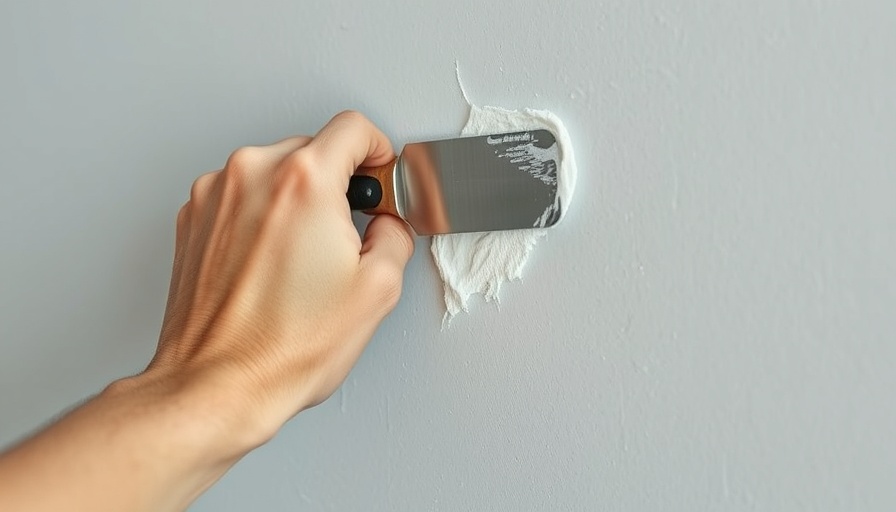
Mastering the Art of Drywall Repairs: A Beginner's Guide
Repairing drywall can seem daunting for many homeowners, but it doesn't have to be. With a little guidance and the right materials, you can tackle this common household issue like a pro. Small holes are not just aesthetically displeasing; they can quickly become larger problems if left unaddressed. This article will guide you through an efficient way to fix these issues, equipping you with the skills necessary to turn those unsightly holes into smooth, seamless walls.
Why Wall Repairs Matter: Aesthetic and Structural Importance
In a state like California, known for its vibrant residential neighborhoods and increasing home values, keeping your home in pristine condition is essential. Not only do repairs enhance the visual appeal of your residence, but they also contribute to the overall structural integrity of your home. Homeowners often overlook small flaws, yet these can lead to more significant issues over time, such as water damage and pest infestations.
The Right Materials: Choosing Quality Spackle for Perfect Results
When it comes to repairing drywall, the right tools and materials are vital. A high-quality spackling compound is a crucial choice for achieving a smooth finish. You'll find a range of spackle options, including lightweight and all-purpose varieties. Opting for lightweight, non-shrinking spackle not only makes for an easier application but ensures long-lasting repairs.
Let There Be Light: The Importance of Good Lighting for Repairs
One often-overlooked tip is to illuminate your workspace effectively. Utilizing a work light not only helps you identify cracks and imperfections that would otherwise go unnoticed but also ensures your repair process is thorough. Proper lighting can reveal areas that may need extra attention, allowing you to address every flaw in one go.
Step-by-Step Repair Process: Making It Easy and Effective
A successful drywall repair consists of a systematic process that involves preparation, application, and finishing touches. Here’s a breakdown of the six essential steps:
- Prepare Your Work Area: Clear the area and position your work light to reveal any hidden flaws.
- Sand Down Loose Pieces: Use a fine-grit sanding sponge or a putty knife to smooth out any edges around the hole.
- Clean the Surface: After sanding, remove any dust with a damp rag to ensure proper adhesion of the spackle.
- Apply Your Spackle: Using a putty knife, firmly fill the hole with spackle and smooth it over the surface.
- Allow to Dry: This phase is critical. Waiting for the spackle to dry completely helps prevent further work down the line.
- Finish with Sanding: Once dry, sand the area lightly until it's flush with the existing wall.
Words to the Wise: Common Mistakes to Avoid
One pitfall for new DIYers is the temptation to rush the drying time. Patience is key; without allowing sufficient time for the spackle to dry, you risk ruining your repair. Additionally, be cautious not to over-sand your work; this could lead to deeper divots that may require additional spackle.
Cost-Effective Home Maintenance: Why DIY Is the Way to Go
Undertaking drywall repairs yourself not only saves you money but also empowers you to take charge of your home maintenance. With minimal expenses (typically ranging from $0 to $20), you can significantly enhance your home’s value, especially in a competitive real estate market like California’s. Potential buyers are often attracted to well-maintained homes that require little immediate work, making these small repairs a worthy investment in your property.
In conclusion, learning how to fix a hole in drywall is not just a useful skill—it's a vital aspect of homeownership. By understanding the tools, techniques, and the importance of proper repairs, you can maintain and enhance your home's aesthetic and structural integrity effectively. Take the leap, and you'll see how satisfying it is to complete a DIY project on your own!
Ready to Embark on Your Repair Journey?
With your newfound knowledge, why not take the next step? Gather your materials, set your workspace, and begin your drywall repair project today. Remember, keeping your home in tip-top shape is not only fulfilling but essential for long-term maintenance and beauty. Don't let those small holes mar your beautiful living space any longer!
 Add Row
Add Row  Add
Add 




Write A Comment